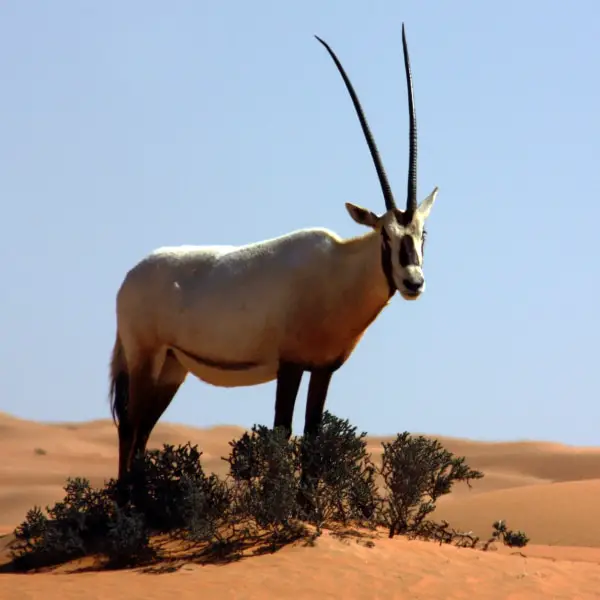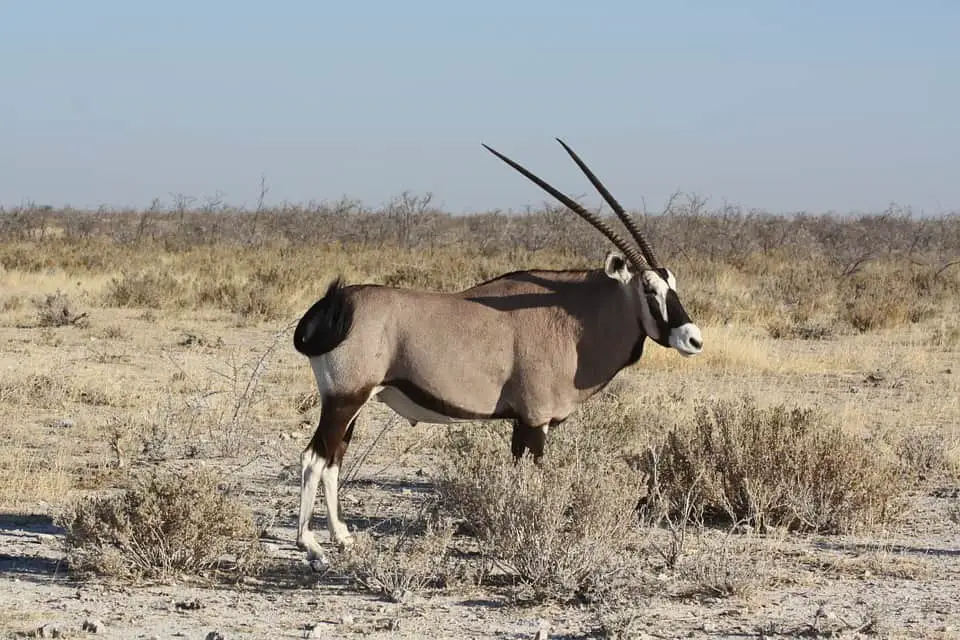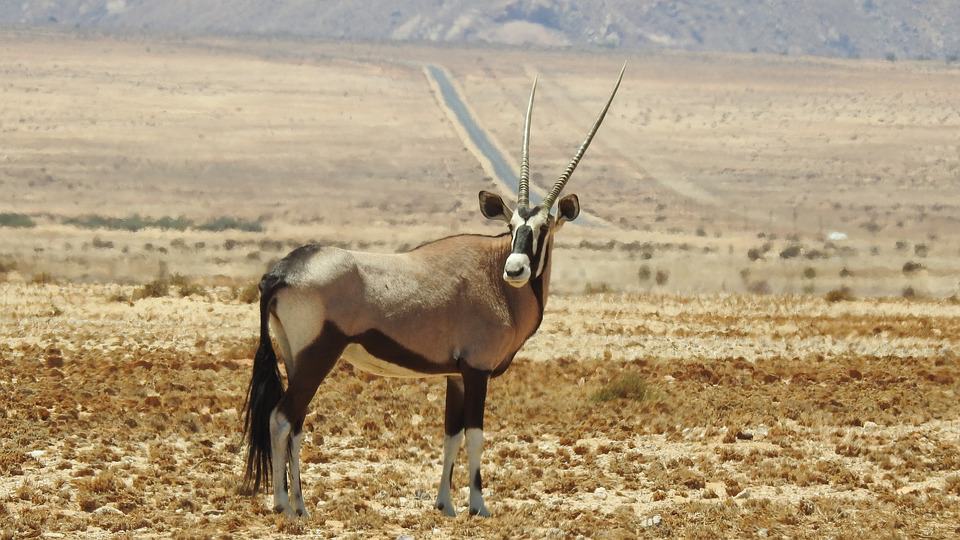Table of Contents
*This post may contain affiliate links. As an Amazon Associate we earn from qualifying purchases.
Most of us know what an antelope is or at least, what an antelope looks like. These fascinating creatures live spread throughout the African continent. What makes them so admirable is their beauty and ability to survive in harsh, arid, hot climates. The subjects of this guide are a particular genus of antelope: The oryx.

Not only are the oryx interesting animals, capable of surviving hot temperatures with little water, but they have a long-standing history connected to humans. We’re going to dive into what makes these animals so interesting.
What Is an Oryx?
The oryx are antelopes native to Africa and the Middle East. There are four species in the genus oryx:
- Scimitar-horned Oryx
- Arabian Oryx
- East African Oryx
- Gemsbok
Out of all these species, both the Arabian Oryx and the Scimitar Oryx reached extinction in the wild. The Arabian Oryx had an extinct classification in the wild back in the 1970s. Private zoos and wildlife preserves saved them and started to reintroduce them to the wild in the 1980s. The Arabian Oryx’s classification has been upgraded to a threatened species, and they are still vulnerable in the wild. The scimitar, on the other hand, became extinct in 2000. People still breed it in captivity.
Importance of the Oryx
The oryx has strong cultural ties with humans. The Arabian Oryx, for instance, has been the subject of poetry. It is a symbol of survival and beauty. In fact, it is in many sculptures and antiquities of the Arabian Peninsula. All animals have their place in the ecosystem, but many oryxes have cultural importance to people. Not surprisingly, the Arabian Oryx is the national animal of Jordan, the United Arab Emirates, Bahrain, Oman and Qatar.
What To Know About the Oryx
When it comes to facts about the oryx, there is a lot of fascinating information to sift through. These animals have been documented and considered the subject of legends for a couple of thousand years. Here are some of the things you need to know to understand oryxes and their how they behave and live.
Physical Description
Oryx are large antelopes, known for their long, straight horns. At over four feet at the shoulder, these massive animals can weigh up to 450 pounds. Their necks are thick, with short manes. Size wise, they are compact and incredibly muscular. What makes them even more distinct are their markings. Most of their body’s fur is fawn, whereas their faces are white. Then, black markings accent their faces, throat, chest and legs. On their head, these markings are triangular, with broad stripes that begin at the base of the horns and then extend to the neck. Their forelegs have a black ring around them, whereas their tail has a black tip. Now, some oryxes, such as the Arabian oryx, has white fur that is sometimes missing the leg stripes. However, their legs may be a darker color than the rest of the body.
Both the males and females of the species have horns. As said before, these horns are long and straight, with the exception of scimitar oryx, which has horns that curve backwards at the ends. There are minor differences with the horns, however, between males and females. The females tend to have longer, thinner horns than the males do.
Habitat
For the most part, oryxes live in deserts, stony flats, savannas, steppes and semi-desert environments. Interestingly, you can find them in Eastern and Southern Africa, the United Arab Emirates, Jordan and Oman. The oryx is used to and thrives in hot, arid climates. Due to the desert-like conditions that they prefer, every species of oryx can survive without water for long lengths of time.
Their fur’s light color helps reflect the desert heat and sunlight, whereas it can also keep them warm on cold winter mornings. They not only use their fur to deal with the cold, but they have a thick undercoat to keep them warm. Keep in mind while they live in hot environments, their habitats can become frigid at night and during the winter.
They adapt to hot climates due to their circulatory system. An interesting fact to note about these animals is that they can cool the blood that flows to their brain when they breathe! They do this by using the capillaries inside their nose. The fringe-eared oryx, or Beisa oryx, are also capable of raising their total body temperature. They raise it up to 115 degrees Fahrenheit so that their body is warmer than the air around them. If it does get too hot, however, they will dig holes to rest away from the sun.
Diet
Like all antelope, oryxes are herbivores. This means that they survive solely off plants. Given their hot, dry climates, however, food is not always plentiful. They travel in herds, sometimes of over 100 members, looking for food and water. Since they live in hot areas, they tend to search for food when it’s coolest out. This means that they go out in early mornings and late afternoons.
Their diets consist of leaves, grass, thorny bushes and other vegetation. Sometimes, they will even dig for tubers and roots. The size of their herd is sometimes dependent on how easily they can find their food sources. For instance, a herd may be larger if they have an expanse of fresh vegetation. These are mega-herds.
An oryx spends most of its day reclining in the shade to regulate their body temperature. Since oryxes are ruminants, they have to have a chance to digest their food and chew their cud each day. As the seasons change, the herds migrate from place to place. Usually, one female leads these migrations, whereas the dominant male takes up the end of the march. Now, if they cannot find water, the oryxes are still survivors. They can live off the moisture from the pants that they eat, or they can survive on the dew on plants and rocks.
Behavior
The oryx lives in herds, which are a mix of males, females and their young. The males who live among the females and their young are non-territorial. Now, there are territorial males, and generally, the oldest male leads the herd. Territorial males will mark out their territory with dung. They decide the dominant male through conflict, and as calves, oryxes will test one another by fighting. However, if there is a clear hierarchy, the need to fight is stifled. The only times where they may fight is when there are two matched oryxes that need to establish their rank.
Herds are always changing. If oryxes need to find water, they will have a group that searches for water. When you have a group of young and their mothers, this herd tends to move slowly. The herds focus on the individual needs of the oryxes, so herds can disband and form very quickly.
The females in the herd can birth calves at any time of year. Once they give birth, they will hide the calf for about three weeks. These mothers will go to and from the herd, visiting the baby a few times a day to feed it. The calves don’t receive their black markings until they are a few weeks old and then they join the herd. At about six to nine months, the calves stop nursing, and then at about 18 months, they will venture off to find a new group.
Interesting Facts About the Oryx
The oryxes are an adaptable genus with a long, fascinating history. Here are some interesting facts that you may not have known:
- Oryxes can take down lions with their long horns
- Due to their horns, their nickname is saber antelope
- The Arabian Oryx’s skin does not have a glare or reflection; they can seem almost invisible at 100 meters
- A baby oryx knows how to run as soon as it’s born and can keep up with its mother
- Female oryxes have one calf per year
- Oryxes are believed to be where the unicorn myth originated
- Oryxes can run up to 37 miles per hour
- Oryxes will stand sideways to make themselves look larger when it means to scare off predators
- Oryx pregnancies last 8 and a half months
- Oryxes live about 20 years in the wild or in captivity.
Conclusion: Conservation Preserves Oryxes

Unfortunately, the history of oryxes has its dark spots. Even now, oryxes are subject to hunters for their spear-like horns. It isn’t the natural predators that caused the decline in oryx breeds. Humans caused a lot of strife for these animals. When it comes down to it, however, the oryx is an incredible animal. It is a large antelope, not only capable of surviving in harsh conditions, but it can also take on its predators.
These animals live uniquely to many herd animals, in that they travel in groups who focus on the needs of the individual and travel with males and females a part of the same herd. Oryxes are a vital part of their desert ecosystem, and this is why it’s important to preserve them. While there are many private establishments that still breed each type of oryx, it is important to save them. Their lives in the wild are both vital and fascinating.

